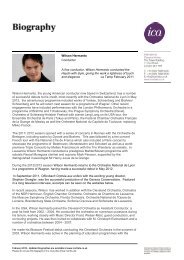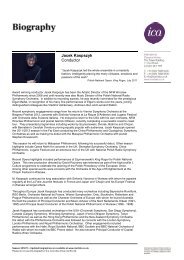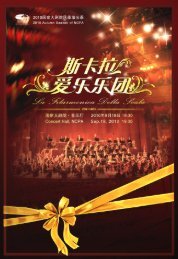to download - International Classical Artists
to download - International Classical Artists
to download - International Classical Artists
Create successful ePaper yourself
Turn your PDF publications into a flip-book with our unique Google optimized e-Paper software.
KARAJAN AND THE VIENNA<br />
PHILHARMONIC IN LONDON<br />
‘A packed and raving audience attended last night <strong>to</strong><br />
Herbert von Karajan and the Vienna Philharmonic in the<br />
Royal Festival Hall’ reported Neville Cardus in The<br />
Guardian on 7 April 1962. The hall was certainly packed.<br />
And perhaps by the end we were, indeed, ‘raving’ after<br />
Karajan and this most distinguished of opera orchestras<br />
had offered a glowing account of Wagner’s Meistersinger<br />
Prelude (sadly not preserved) by way of encore.<br />
In 1934 Cardus had written of the Vienna Philharmonic<br />
‘in all the absorbed mastery of its art’ giving glowing<br />
performances of symphonies by Mozart and Brahms under<br />
the direction of Bruno Walter. Such visits had, alas,<br />
remained a rarity. Little wonder, then, that this 1962<br />
concert had about it something of the air of a state visit.<br />
Karajan’s presence added a further dimension. The<br />
Vienna Philharmonic has no principal conduc<strong>to</strong>r but its de<br />
fac<strong>to</strong> head is the Direc<strong>to</strong>r of the Vienna State Opera, a<br />
position Karajan had held since 1957. His reper<strong>to</strong>ry, during<br />
a seven-year reign which has since acquired the reputation<br />
of a golden age, ranged from Monteverdi <strong>to</strong> Pizzetti. A<br />
fabled staging of Debussy’s Pelléas et Mélisande, which<br />
had opened some weeks previously, and new productions<br />
of Tristan und Isolde and Parsifal were particular highlights.<br />
Something of that superbly wrought Wagnerian sound<br />
culture can be heard in this London performance of<br />
Bruckner’s Seventh Symphony.<br />
There were other points of interest <strong>to</strong>o. Karajan with the<br />
Vienna Philharmonic was a rather different conduc<strong>to</strong>r from<br />
Karajan with the Berlin Philharmonic. Deeply versed in the<br />
Vienna Philharmonic’s interpretative traditions and<br />
distinctive sound quality, he was more inclined <strong>to</strong> fashion<br />
his Vienna performances from within, rather than impose<br />
2<br />
them from without. He could also be a very different<br />
conduc<strong>to</strong>r live from the one whose finely honed studio<br />
recordings sold in their millions round the globe.<br />
As a Mozart interpreter Karajan had much in common<br />
with Bruno Walter. His true men<strong>to</strong>r, though, was Richard<br />
Strauss, the classicising romantic whose reading of the<br />
‘Jupiter’ Symphony Karajan’s closely resembles in both<br />
tempo and internal modelling. A recording exists of Karajan<br />
rehearsing the slow movement of the ‘Jupiter’ in Berlin in<br />
1970. From the very first note, a muted F in the first<br />
violins, he requires a particular colour and sustained<br />
beauty of sound. At bar 11, after the lower strings have<br />
played one of the most heavenly six-note phrases in all<br />
Mozart, punctuated by demisemiquaver flurries in the<br />
violins, he intervenes. ‘No, gentlemen, you get that on<br />
every single recording! It’s fine as an exercise in precision<br />
but it’s horrible. Please now: ardent and profound.’ In the<br />
movement’s coda, a further skirl of demisemiquavers for<br />
flutes and bassoons is said <strong>to</strong> be <strong>to</strong>o ‘au<strong>to</strong>matic’. It must,<br />
says Karajan, be ‘like a flurry of tiny wavelets on a smooth<br />
sheet of water’. As Maynard Solomon writes in Mozart: A<br />
Life: ‘Such moments wait <strong>to</strong> be discovered: they are<br />
transitional, passing references <strong>to</strong> pure beauty, captured for<br />
an instant before they sink back in<strong>to</strong> the relative quotidian.’<br />
The performances of both the Mozart and the Bruckner<br />
symphonies are quicker here than on any of Karajan’s<br />
studio recordings. (A reflection, possibly, of the Royal<br />
Festival Hall’s no<strong>to</strong>riously dry acoustic.) They are also freer<br />
in places and given <strong>to</strong> a number of as<strong>to</strong>nishing build-ups<br />
of power. Ot<strong>to</strong> Strasser, who was a member of the Vienna<br />
Philharmonic from 1926 <strong>to</strong> 1967 and who led the second<br />
violins during this concert, <strong>to</strong>ld the present writer, ‘In the<br />
actual performance, especially in operas when he directed<br />
with open eyes, an unbelievable power and tension<br />
radiated from him. I always saw him from very close at<br />
hand: the muscles of his conducting arm were often as<br />
tense as they could be. He suffered sometimes from<br />
painful cramps in the hand, which he overcame with great<br />
difficulty. He never spared himself when standing on the<br />
rostrum.’ Strasser also recalled how in rehearsal Karajan<br />
mixed rigorous analysis with telling eloquence. He recalled<br />
a number of phrases from a Karajan Bruckner rehearsal.<br />
‘The upbeat here, please, especially arduous.’ ‘The<br />
beauty of this passage must be heard <strong>to</strong> lie in its sense<br />
of resignation.’<br />
In 1962 audiences beyond the borders of<br />
Austro-Germany knew little of Karajan’s Bruckner. With the<br />
exception of his epic 1957 Berlin recording of the Eighth<br />
Symphony, his celebrated opus of Bruckner recordings<br />
dates exclusively from the years 1966–89. Perhaps it<br />
comes as no surprise, then, that this London account of the<br />
Seventh Symphony, played by the orchestra Bruckner<br />
himself had known and written for, came as something of<br />
a revelation.<br />
‘Noble Height in Bruckner: Vibrant Vienna<br />
Philharmonic’ ran the headline over a review in London’s<br />
Daily Telegraph. ‘London has not heard a Bruckner<br />
performance of this quality for years,’ wrote critic Donald<br />
Mitchell, who singled out for particular mention Karajan’s<br />
mastery of the long phrase and his ‘quite special sense of<br />
musical continuity’. For some reviewers it was the majestic<br />
unfolding of the symphony’s outer movements which <strong>to</strong>ok<br />
their breath away. For Mitchell it was the slow movement:<br />
in particular the superbly built climax and its brooding<br />
coda, Bruckner’s threnody for the dead Wagner, where the<br />
music-making, Mitchell suggested, was ‘undoubtedly<br />
<strong>to</strong>uched by interpretative genius’.<br />
Richard Osborne<br />
KARAJAN ET LE PHILHARMONIQUE DE<br />
VIENNE À LONDRES<br />
“Une salle comble et délirante entendit hier soir Herbert<br />
von Karajan et le Philharmonique de Vienne au Royal<br />
Festival Hall”, écrit Neville Cardus dans The Guardian<br />
du 7 avril 1962. La salle était certainement comble. Et<br />
peut-être étions-nous vraiment “délirants” à la fin, après<br />
la superbe lecture du Prélude des Maîtres Chanteurs de<br />
Wagner donnée en guise de bis par Karajan et son<br />
orchestre lyrique des plus distingués (mais<br />
malheureusement non conservée).<br />
En 1934, Cardus avait évoqué les radieuses<br />
interprétations de symphonies de Mozart et Brahms<br />
données sous la direction de Bruno Walter par le<br />
Philharmonique de Vienne, “dans <strong>to</strong>ute la maîtrise<br />
concentrée de son art”. De telles visites étaient hélas<br />
restées rares. Il n’est donc pas é<strong>to</strong>nnant que ce concert de<br />
1962 ait eu un peu des allures de visite d’État.<br />
La présence de Karajan y ajoutait une dimension<br />
supplémentaire. Le Philharmonique de Vienne n’a pas de<br />
chef principal, mais son chef de fac<strong>to</strong> est le directeur de<br />
l’Opéra d’État de Vienne, fonction que Karajan occupait<br />
depuis 1957. Son réper<strong>to</strong>ire, au cours d’un règne de sept<br />
ans qui, depuis, s’est fait une réputation d’âge d’or, allait<br />
de Monteverdi à Pizzetti. Une mise en scène légendaire de<br />
Pelléas et Mélisande de Debussy, donnée pour la première<br />
fois quelques semaines auparavant, et de nouvelles<br />
productions de Tristan und Isolde et de Parsifal furent en<br />
particulier des temps forts. Un peu de cette culture sonore<br />
wagnérienne superbement ouvragée s’entend dans cette<br />
interprétation londonienne de la Septième Symphonie<br />
de Bruckner.<br />
Il y avait d’autres aspects intéressants aussi. Karajan<br />
avec le Philharmonique de Vienne était un chef assez<br />
3

















